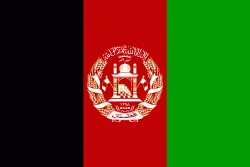Kushk District (Kushk)
Kushk District is situated in the northern part of Herat Province, Afghanistan and also may be referred to as Rubat-i-Sangin or Rabat-e-Sangi. It borders Turkmenistan to the north, Gulran District to the west, Zinda Jan District, Injil District and Karukh District to the south and Kushki Kuhna District to the east. The population is 121,000 (2012).
The main road from Herat to Kushka in Turkmenistan passes through the district, along the Kushk River. Torghundi is the main border crossing town.
The following table demonstrates the total amount of irrigated and rain-fed lands in the district.
The main road from Herat to Kushka in Turkmenistan passes through the district, along the Kushk River. Torghundi is the main border crossing town.
The following table demonstrates the total amount of irrigated and rain-fed lands in the district.
Map - Kushk District (Kushk)
Map
Country - Afghanistan
 |
 |
| Flag of Afghanistan | |
Human habitation in Afghanistan dates back to the Middle Paleolithic era, and the country's strategic location along the historic Silk Road has led it to being described, picturesquely, as the ‘roundabout of the ancient world’. Popularly referred to as the graveyard of empires, the land has historically been home to various peoples and has witnessed numerous military campaigns, including those by the Persians, Alexander the Great, the Maurya Empire, Arab Muslims, the Mongols, the British, the Soviet Union, and most recently by a US-led coalition. Afghanistan also served as the source from which the Greco-Bactrians and the Mughals, amongst others, rose to form major empires. The various conquests and periods in both the Iranian and Indian cultural spheres made the area a center for Zoroastrianism, Buddhism, Hinduism, and later Islam throughout history.
Currency / Language
| ISO | Currency | Symbol | Significant figures |
|---|---|---|---|
| AFN | Afghan afghani | Ø‹ | 2 |
| ISO | Language |
|---|---|
| PS | Pashto language |
| FA | Persian language |
| TK | Turkmen language |
| UZ | Uzbek language |















